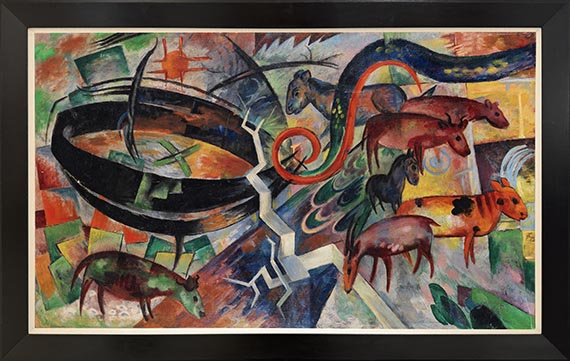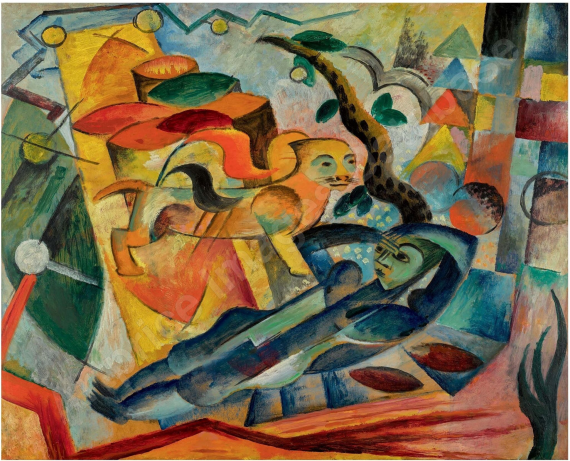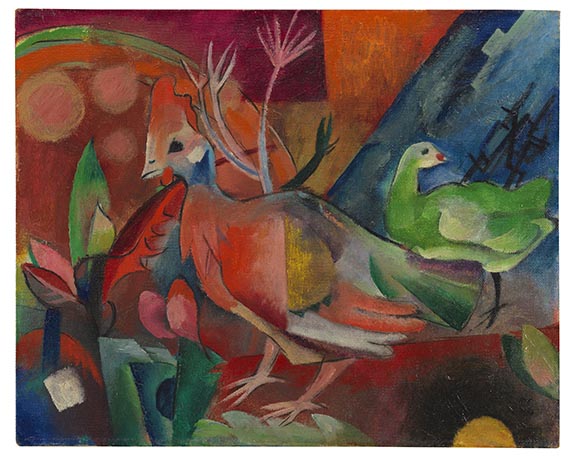121002576
Heinrich Campendonk
Landschaft mit Tieren, Um 1913.
Oil on cardboard, laid on auf fiberboard and mo...
Stima: € 600,000 / $ 642,000
Le informationi sulla commissione, le tasse e il diritto di seguito saranno disponibili quattro settimane prima dell´asta.
Landschaft mit Tieren. Um 1913.
Oil on cardboard, laid on auf fiberboard and mounted in a stretcher.
With the label of Galerie Aenne Abels, Cologne on the reverse, typographically inscribed "Campendonck / Tiere an der Tränke Gemälde / I.N. 1360", with a label of "Niere[?]" below, as well as with the stamp "Hauptzollamt Köln Rheinau". Verso of the stretcher with the label of Galerie Alfred Flechtheim, inscribed "Nr. 501 / Campendonk Seeshaupt / Landschaft mit Tieren", as well as with several 'Köln-Rheinau' customs stamps. 70 x 120 cm (27.5 x 47.2 in).
[KT].
• From the artist's most innovative creative period: he participated in the important exhibitions of the "Blauer Reiter" and Rhenish Expressionism in 1911 and 1913.
• Campendonk developed his own profound pictorial language in exchange with Franz Marc.
• This work was shown in major exhibitions at the most important galleries of the time (Walden and Flechtheim).
• Museum quality of this size is very rare..
We are grateful to Ev Raue, Berlin, for her kind expert advice.
PROVENANCE: Galerie Alfred Flechtheim, Düsseldorf (Whitsun 1920, with the label on the reverse).
Galerie Nierendorf Cologne - Neue Kunst (c. 1920/24, possibly 1923, with a fragmentary label on the reverse).
Kunstgalerie Aenne Abels alter und neuer Meister, Cologne-Lindenthal (no later than May 10, 1954 - at least October 10, 1955).
Private collection.
Private collection, North Rhine-Westphalia (gifted by the above in the early 1970s).
EXHIBITION:
66th exhibition: Heinrich Campendonk, Walter Dexel, Galerie Der Sturm, Berlin, 1918, no. 7.
Heinrich Campendonk - Josef Eberz, Galerie Flechtheim, Düsseldorf, Whitsun - June 12, 1920, p. 6, no. 9 (with the label).
Heinrich Campendonk, Museum Haus Lange, Krefeld, May 25 - July 17, 1960, p. 78, no. 11 (illu.).
LITERATURE:
Andrea Firmenich, Heinrich Campendonk 1889-1957, Leben und expressionistisches Werk, mit Werkkatalog des malerischen Oeuvres, Recklinghausen 1989, no. 372 (illu. in b/w).
- -
Weltkunst, vol. 24, no. 22, Nov. 1954, p. 4 (ill.).
Aenne Abels - Kunstgalerie alter und neuer Meister, Cologne (October 1955), n. p. 1955, illu. in b/w.
Gregor Langfeld, Duitse kunst in Nederland - verzamelen, tentoonstellen, kritieken. 1919-1964, Zwolle 2004, p. 271, note 366
ARCHIVE MATERIAL
Letter from Aenne Abels to Herta Hesse-Freilinghaus, May 10, 1954, Osthaus Museum Hagen, Documentation, File I. Acquisitions.
Letter from Aenne Abels to Erich Wiese, July 1, 1954, Archive Hessian State Museum, General Correspondence 1953-55 (File 1), today: Hessian State Archive Darmstadt.
Oil on cardboard, laid on auf fiberboard and mounted in a stretcher.
With the label of Galerie Aenne Abels, Cologne on the reverse, typographically inscribed "Campendonck / Tiere an der Tränke Gemälde / I.N. 1360", with a label of "Niere[?]" below, as well as with the stamp "Hauptzollamt Köln Rheinau". Verso of the stretcher with the label of Galerie Alfred Flechtheim, inscribed "Nr. 501 / Campendonk Seeshaupt / Landschaft mit Tieren", as well as with several 'Köln-Rheinau' customs stamps. 70 x 120 cm (27.5 x 47.2 in).
[KT].
• From the artist's most innovative creative period: he participated in the important exhibitions of the "Blauer Reiter" and Rhenish Expressionism in 1911 and 1913.
• Campendonk developed his own profound pictorial language in exchange with Franz Marc.
• This work was shown in major exhibitions at the most important galleries of the time (Walden and Flechtheim).
• Museum quality of this size is very rare..
We are grateful to Ev Raue, Berlin, for her kind expert advice.
PROVENANCE: Galerie Alfred Flechtheim, Düsseldorf (Whitsun 1920, with the label on the reverse).
Galerie Nierendorf Cologne - Neue Kunst (c. 1920/24, possibly 1923, with a fragmentary label on the reverse).
Kunstgalerie Aenne Abels alter und neuer Meister, Cologne-Lindenthal (no later than May 10, 1954 - at least October 10, 1955).
Private collection.
Private collection, North Rhine-Westphalia (gifted by the above in the early 1970s).
EXHIBITION:
66th exhibition: Heinrich Campendonk, Walter Dexel, Galerie Der Sturm, Berlin, 1918, no. 7.
Heinrich Campendonk - Josef Eberz, Galerie Flechtheim, Düsseldorf, Whitsun - June 12, 1920, p. 6, no. 9 (with the label).
Heinrich Campendonk, Museum Haus Lange, Krefeld, May 25 - July 17, 1960, p. 78, no. 11 (illu.).
LITERATURE:
Andrea Firmenich, Heinrich Campendonk 1889-1957, Leben und expressionistisches Werk, mit Werkkatalog des malerischen Oeuvres, Recklinghausen 1989, no. 372 (illu. in b/w).
- -
Weltkunst, vol. 24, no. 22, Nov. 1954, p. 4 (ill.).
Aenne Abels - Kunstgalerie alter und neuer Meister, Cologne (October 1955), n. p. 1955, illu. in b/w.
Gregor Langfeld, Duitse kunst in Nederland - verzamelen, tentoonstellen, kritieken. 1919-1964, Zwolle 2004, p. 271, note 366
ARCHIVE MATERIAL
Letter from Aenne Abels to Herta Hesse-Freilinghaus, May 10, 1954, Osthaus Museum Hagen, Documentation, File I. Acquisitions.
Letter from Aenne Abels to Erich Wiese, July 1, 1954, Archive Hessian State Museum, General Correspondence 1953-55 (File 1), today: Hessian State Archive Darmstadt.
In Upper Bavaria, Heinrich Campendonk successfully pushed ahead with his artistic development, creating a unique visual language and a profound, enigmatic imagery. Campendonk was invited to take part in the first exhibition of the "Blaue Reiter" in Munich, and in 1913 he also showed works at the exhibitions "Rheinische Expressionisten" in Bonn and the "Erster Deutscher Herbstsalon" at Herwarth Walden's gallery "Der Sturm" in Berlin, all important exhibitions of classical Modernism before the World War I, a period in which Campendonk created seminal works in all techniques, of which this exceptional and large painting "Landschaft mit Tieren" is a prime example.
On the recommendation of Wassily Kandinsky, the young Heinrich Campendonk, a student of Jan Thorn-Prikker at the College of Textile Science in Krefeld, convinced the art dealer, collector, publicist and publisher Alfred Flechtheim, one of the most important supporters of the avant-garde, to become his patron in 1911. Flechtheim acquired his first works and supported the artist's pioneering trip to Sindelsdorf in Upper Bavaria, where Franz Marc lived. A letter from October 7, 1911, that Campendonk wrote to his friend Adda Deichmann shortly after his arrival, reveals just how intensive and formative his contact with the artists of "Der Blaue Reiter", Wassily Kandinsky and Franz Marc, was at the time: "I arrived in Munich at seven in the morning and met [Helmuth] Macke an hour later. In the afternoon we were at Kandinsky's, where we saw great things and met Mr. Kuno Amiet as well as some other gentlemen. On Monday we went to Salon Thannhauser and the Pinakothek and also met Erbslöh. In the evening, we drove to Penzberg with Macke's cousin [August] , where Mr. Marc picked us up in his car, and we made our way to the strange place of Sindelsdorf." (quoted from: Andrea Firmenich, Heinrich Campendonk, Recklinghausen 1989, p. 25). They took a first group picture on the balcony of Kandinsky's city apartment (fig. 1), a document of the time of intensive discussions and planning for the publication of the almanac "Der Blaue Reiter".
Campendonk's university friend Helmuth Macke and his cousin August had arranged this encounter for him. From the fall of 1911, he and his future wife Adda were living in the immediate vicinity of Franz and Maria Marc in Sindelsdorf. After Marc was killed in the war in March 1916, Campendonk moved to Seeshaupt at the southern end of Lake Starnberg the following May. Hence, the years of his artistic development were characterized by the close connection to the artists around the "Blue Rider", as well as by an intensive connection to the Upper Bavarian landscape around Sindelsdorf and Seeshaupt, and later also by the surroundings of the small mining town of Penzberg a little further south.
In these early years in Upper Bavaria, Campendonk's work clearly bears the influence of Franz Marc. Both artists made their own versions of these bizarre animal scenes and landscapes transformed into fairy tales, rural idylls immersed in a dreamlike and contemplative solitude in luminous colors. "The area around Sindelsdorf was hilly, with elevations alternating with depressions," Maria Marc recalls. "There were these sloping pastures with interesting transitions in the terrain. The livestock grazing on them, horses and cattle, offered the observer ever-changing, lively scenes." (Quoted from: Maria Marc, Mein Leben mit Franz Marc, Munich 2016, p. 116). Even in early works such as "Springendes Pferd" (fig. 2) and "Frau mit Reh" (fig. 3) that young Campendonk showed in the first exhibition of the "Blaue Reiter" at Galerie Heinrich Thannhauser in December 1911, his distinctive style becomes evident: A compositional combination of pictorial set pieces in a fixed and at the same time loose context, a content that avoids any kind of narrative. In Campendonk's work, animals are individuals, embedded in an imaginary mesh of landscapes, that at times contradict one another in their painterly conception and their formal intention. Campendonk's style around this time was determined by a juxtaposition of landscape planes, a division of the pictorial surface into disintegrated, seemingly cubic 'levels' assembled from very different 'models'. A variety of animals moves within a world of fenced boundaries, enclosed celestial gardens laid out across the canvas that structure the composition and add a certain coherence. A compelling narrative is avoided. Campendonk lines things up more than he connects them; everything is described in a certain flow. The result is an illusion, a hovering state between lyrical abstraction and natural objectivity that cannot be interpreted in either way. They are painted riddles that are to be grasped in their entirety and seen as such. This is where Campendonk clearly differs from Franz Marc.
The beginning of the First World War divided the artists around the "Blauer Reiter", and their common ideas would only be promoted through the commitment of the Berlin gallerist and publisher Herwarth Walden. Franz Marc, as well as August and Helmuth Macke enrolled as volunteers, while Wassily Kandinsky and Alexej von Jawlensky had to leave Germany as Russian citizens. The former returns to Moscow while the latter sought asylum in Switzerland. Campendonk refused to serve, but he was drafted and discharged shortly after in the spring of 1915 due to illness. August Macke was killed in September 1914, Franz Marc in March 1916; the loss of both friends and artistic patrons affected Campendonk particularly severely. He moved to a farmhouse in Seeshaupt on Lake Starnberg, where he lived in seclusion trying to overcome the horrors of the war and emancipating himself from the style of the "Blaue Reiter" in a decisive way, eventually attaining his very own style.
In 1920, Campendonk went on a trip to Italy, and Flechtheim, who had been promoting the painter in group exhibitions since 1914, organized a solo exhibition. In 1923, the artist returned to Krefeld, and was appointed professor at the School of Applied Arts in Essen, before his call to the Düsseldorf Art Academy in 1926. The National Socialists dismissed Campendonk after they had seized power, but he was appointed professor at the Rijksakademie in Amsterdam in 1935. In 1937, he was defamed in the inflammatory publication "Säuberung des Kunsttempels" (Purge of the Art Temple), and his works were also shown in the "Degenerate Art" exhibition. In 1944, Campendonk was able to hide from the German occupying forces and continued to teach after the war. The artist died in Amsterdam on May 9, 1957. [MvL]
On the recommendation of Wassily Kandinsky, the young Heinrich Campendonk, a student of Jan Thorn-Prikker at the College of Textile Science in Krefeld, convinced the art dealer, collector, publicist and publisher Alfred Flechtheim, one of the most important supporters of the avant-garde, to become his patron in 1911. Flechtheim acquired his first works and supported the artist's pioneering trip to Sindelsdorf in Upper Bavaria, where Franz Marc lived. A letter from October 7, 1911, that Campendonk wrote to his friend Adda Deichmann shortly after his arrival, reveals just how intensive and formative his contact with the artists of "Der Blaue Reiter", Wassily Kandinsky and Franz Marc, was at the time: "I arrived in Munich at seven in the morning and met [Helmuth] Macke an hour later. In the afternoon we were at Kandinsky's, where we saw great things and met Mr. Kuno Amiet as well as some other gentlemen. On Monday we went to Salon Thannhauser and the Pinakothek and also met Erbslöh. In the evening, we drove to Penzberg with Macke's cousin [August] , where Mr. Marc picked us up in his car, and we made our way to the strange place of Sindelsdorf." (quoted from: Andrea Firmenich, Heinrich Campendonk, Recklinghausen 1989, p. 25). They took a first group picture on the balcony of Kandinsky's city apartment (fig. 1), a document of the time of intensive discussions and planning for the publication of the almanac "Der Blaue Reiter".
Campendonk's university friend Helmuth Macke and his cousin August had arranged this encounter for him. From the fall of 1911, he and his future wife Adda were living in the immediate vicinity of Franz and Maria Marc in Sindelsdorf. After Marc was killed in the war in March 1916, Campendonk moved to Seeshaupt at the southern end of Lake Starnberg the following May. Hence, the years of his artistic development were characterized by the close connection to the artists around the "Blue Rider", as well as by an intensive connection to the Upper Bavarian landscape around Sindelsdorf and Seeshaupt, and later also by the surroundings of the small mining town of Penzberg a little further south.
In these early years in Upper Bavaria, Campendonk's work clearly bears the influence of Franz Marc. Both artists made their own versions of these bizarre animal scenes and landscapes transformed into fairy tales, rural idylls immersed in a dreamlike and contemplative solitude in luminous colors. "The area around Sindelsdorf was hilly, with elevations alternating with depressions," Maria Marc recalls. "There were these sloping pastures with interesting transitions in the terrain. The livestock grazing on them, horses and cattle, offered the observer ever-changing, lively scenes." (Quoted from: Maria Marc, Mein Leben mit Franz Marc, Munich 2016, p. 116). Even in early works such as "Springendes Pferd" (fig. 2) and "Frau mit Reh" (fig. 3) that young Campendonk showed in the first exhibition of the "Blaue Reiter" at Galerie Heinrich Thannhauser in December 1911, his distinctive style becomes evident: A compositional combination of pictorial set pieces in a fixed and at the same time loose context, a content that avoids any kind of narrative. In Campendonk's work, animals are individuals, embedded in an imaginary mesh of landscapes, that at times contradict one another in their painterly conception and their formal intention. Campendonk's style around this time was determined by a juxtaposition of landscape planes, a division of the pictorial surface into disintegrated, seemingly cubic 'levels' assembled from very different 'models'. A variety of animals moves within a world of fenced boundaries, enclosed celestial gardens laid out across the canvas that structure the composition and add a certain coherence. A compelling narrative is avoided. Campendonk lines things up more than he connects them; everything is described in a certain flow. The result is an illusion, a hovering state between lyrical abstraction and natural objectivity that cannot be interpreted in either way. They are painted riddles that are to be grasped in their entirety and seen as such. This is where Campendonk clearly differs from Franz Marc.
The beginning of the First World War divided the artists around the "Blauer Reiter", and their common ideas would only be promoted through the commitment of the Berlin gallerist and publisher Herwarth Walden. Franz Marc, as well as August and Helmuth Macke enrolled as volunteers, while Wassily Kandinsky and Alexej von Jawlensky had to leave Germany as Russian citizens. The former returns to Moscow while the latter sought asylum in Switzerland. Campendonk refused to serve, but he was drafted and discharged shortly after in the spring of 1915 due to illness. August Macke was killed in September 1914, Franz Marc in March 1916; the loss of both friends and artistic patrons affected Campendonk particularly severely. He moved to a farmhouse in Seeshaupt on Lake Starnberg, where he lived in seclusion trying to overcome the horrors of the war and emancipating himself from the style of the "Blaue Reiter" in a decisive way, eventually attaining his very own style.
In 1920, Campendonk went on a trip to Italy, and Flechtheim, who had been promoting the painter in group exhibitions since 1914, organized a solo exhibition. In 1923, the artist returned to Krefeld, and was appointed professor at the School of Applied Arts in Essen, before his call to the Düsseldorf Art Academy in 1926. The National Socialists dismissed Campendonk after they had seized power, but he was appointed professor at the Rijksakademie in Amsterdam in 1935. In 1937, he was defamed in the inflammatory publication "Säuberung des Kunsttempels" (Purge of the Art Temple), and his works were also shown in the "Degenerate Art" exhibition. In 1944, Campendonk was able to hide from the German occupying forces and continued to teach after the war. The artist died in Amsterdam on May 9, 1957. [MvL]
121002576
Heinrich Campendonk
Landschaft mit Tieren, Um 1913.
Oil on cardboard, laid on auf fiberboard and mo...
Stima: € 600,000 / $ 642,000
Le informationi sulla commissione, le tasse e il diritto di seguito saranno disponibili quattro settimane prima dell´asta.




 Lot 121002576
Lot 121002576 


